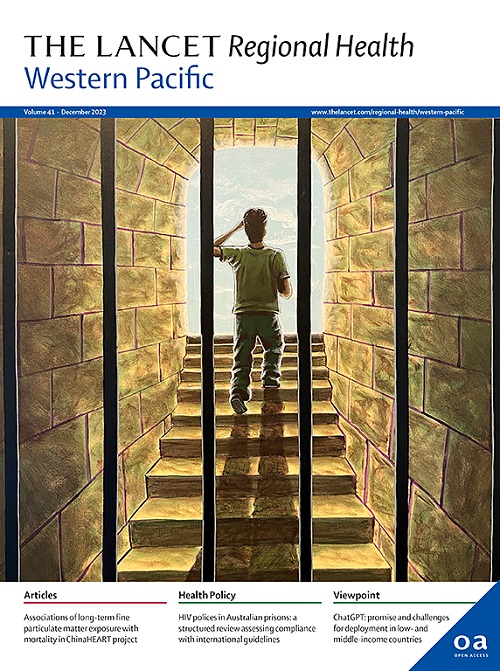估算新西兰痴呆症发病率:将捕获-再捕获模型应用于常规收集的关联健康数据集的队列研究
IF 7.6
1区 医学
Q1 HEALTH CARE SCIENCES & SERVICES
引用次数: 0
摘要
背景在常规收集的健康数据中,痴呆症诊断不足和编码不足的问题限制了这些数据在估算新西兰奥特亚罗瓦(Aotearoa New Zealand,NZ)痴呆症患病率和发病率方面的实用性。捕获-再捕获技术可以通过模拟关联数据源之间的关系和相互作用来估算健康数据集中缺失的痴呆症病例数。本研究的目的是将这一技术应用于常规收集和关联的健康数据集,并更准确地估算出新西兰的痴呆症发病率。方法从三个关联的国家健康数据集--国际痴呆症研究指数(interRAI)、公立医院出院数据和药房数据中识别出新西兰60岁以上人口中的所有痴呆症病例。捕获-再捕获分析将八个对数线性模型拟合到数据中,用拟合效果最好的模型来估计所有三个数据集中缺失的病例数,从而估计痴呆症的 "真实 "发病率。根据 5 年年龄段、性别和种族计算发病率。60 岁以上年龄组的模型发病率为 19.2(95% CI 17.3-22.0)/1000py,每个 5 年年龄段的发病率比为 1.9(95% CI 1.9-2.0)。男性和女性的发病率没有差异。与欧洲人相比,亚裔(p < 0.001)的发病率明显较低,但毛利人(p = 0.974)和太平洋岛屿族裔(p = 0.110)的发病率却不低,即使在纳入缺失病例后也是如此。这突显出需要更好地进行痴呆症评估和诊断,以便提供适当的支持和干预措施,改善痴呆症患者及其家人的生活质量。本文章由计算机程序翻译,如有差异,请以英文原文为准。
Estimating the incidence of dementia in New Zealand: a cohort study applying capture-recapture modelling to routinely collected linked health datasets
Background
Issues of under-diagnosis and under-coding of dementia in routinely collected health data limit their utility for estimating dementia prevalence and incidence in Aotearoa New Zealand (NZ). Capture-recapture techniques can be used to estimate the number of dementia cases missing from health datasets by modelling the relationships and interactions between linked data sources. The aim of this study was to apply this technique to routinely collected and linked health datasets and more accurately estimate the incidence of dementia in NZ.
Methods
All incident cases of dementia in the NZ 60+ population were identified in three linked national health data sets—interRAI, Public hospital discharges, and Pharmacy. Capture-recapture analysis fitted eight loglinear models to the data, with the best fitting model used to estimate the number of cases missing from all three datasets, and thereby estimate the ‘true’ incidence of dementia. Incidence rates were calculated by 5-year age bands, sex and ethnicity.
Findings
Modelled estimates indicate 36% of incident cases are not present in any of the datasets. Modelled incidence rates in the 60+ age group were 19.2 (95% CI 17.3–22.0)/1000py, with an incident rate ratio of 1.9 (95% CI 1.9–2.0) per 5-year age band. There was no difference in incidence rates between males and females. Incidence rates in Asian (p < 0.001) but not Māori (p = 0.974) or Pacific peoples (p = 0.110) were significantly lower compared to Europeans, even after inclusion of missing cases.
Interpretation
This is the first study to provide estimates of age 60+ dementia incidence in NZ and for the four main ethnic groups and suggests over a third of incident dementia cases are undiagnosed. This highlights the need for better access to dementia assessment and diagnosis so that appropriate supports and interventions can be put in place to improve outcomes for people living with dementia and their families.
Funding
Nil.
求助全文
通过发布文献求助,成功后即可免费获取论文全文。
去求助
来源期刊

The Lancet Regional Health: Western Pacific
Medicine-Pediatrics, Perinatology and Child Health
CiteScore
8.80
自引率
2.80%
发文量
305
审稿时长
11 weeks
期刊介绍:
The Lancet Regional Health – Western Pacific, a gold open access journal, is an integral part of The Lancet's global initiative advocating for healthcare quality and access worldwide. It aims to advance clinical practice and health policy in the Western Pacific region, contributing to enhanced health outcomes. The journal publishes high-quality original research shedding light on clinical practice and health policy in the region. It also includes reviews, commentaries, and opinion pieces covering diverse regional health topics, such as infectious diseases, non-communicable diseases, child and adolescent health, maternal and reproductive health, aging health, mental health, the health workforce and systems, and health policy.
 求助内容:
求助内容: 应助结果提醒方式:
应助结果提醒方式:


